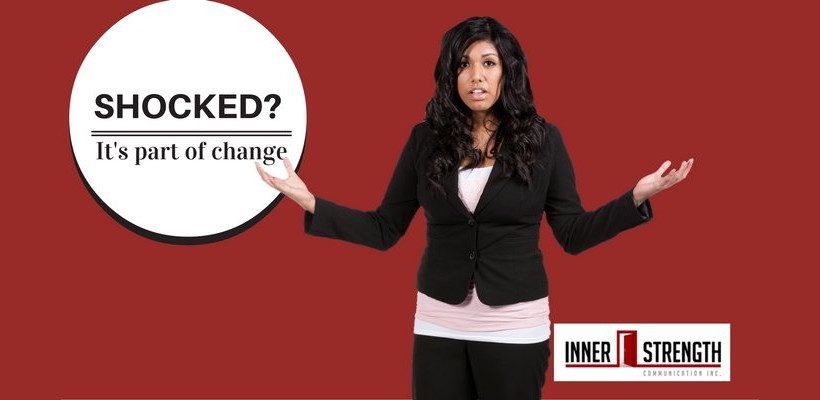
So now what? It's all a part of going through change.
Many of us, especially those outside of the USA, are in a state of shock after the 2016 election results. We never thought that Donald Trump could realistically be the US President-Elect. Yet waking up this morning, we realize it wasn't a dream (or nightmare...depending on where you sit on the issue).
What we all need to know is that SHOCK is a natural part of how we deal with change and that each of us will take our own time to navigate our way around the cycle.
In fact, everyone goes through a cycle of SHOCK, DENIAL, ANGER, RESISTANCE, ACCEPTANCE, ADOPTION and COMMITMENT. Some will go through it faster than others.
As a communication consultant who's taken many organizations through change, I've learned that the need for information during change and transformation is extremely important.
Here are a few things to consider:
There are always different perspectives
Some will be excited about change and see it as an opportunity while others will only see challenges. I remember communicating with several organizations through acquisitions and divestitures. The organization, department, or group that is growing is often excited and energized by the change while others feel fear. Know your audience and adjust messaging and tone based on their perspectives and needs.
Communicate through every phase
While going through the cycle of SHOCK (Huh?), DENIAL (This can't be happening!) and ANGER (I'm really mad now); your stakeholders require facts. For me, it's the awareness stage. What's happening, When is it happening, and a high level of why. I'll always make sure that there are key messages, fact sheets and plenty of information for employees to find at their fingertips and hear from their leaders during this time.
While entering the RESISTANCE (I'd don't care, I'm not going to play in this sandbox) through ACCEPTANCE (I guess I can't do anything about it) phases, we need to take people through the understanding stage. They need communication to help them understand the why and the how. Information in this stage provides background on why decisions were made, what it means for the company and how we will go about navigating the change. It's important to put leaders in front of employees to answer questions and provide perspectives. It's also okay to say you don't have all the answers as long as there is a strategy and plan to get there with regular updates available.
During ADOPTION (What do I do now that things are different?), I focus on communication that explains what we need employees to do to make the change successful. I call it the respond stage. Orientation, training, and change forums help take employees though what it looked like before and what will start, stop and remain the same in the future.
Finally, in order to build COMMITMENT (I actually believe this is going to work), we need to ensure that all communication helps our stakeholders believe in the direction and the benefits of the change. This is the all-important believe stage. Messaging, regular communication of milestones and wins, along with building trust through transparent communication are key.
Don't let the rumour mill take over
The more proactive the communication plan and the more visible the leader, the greater the degree of success and adoption you will have. What I know for sure is that during times of change and anxiety, when information is not provided, people make it up themselves. And the risk of letting that happen? Your best people leave (did you hear that the Canadian immigration site crashed last night?), some people stick around and stop delivering, while others deliberately sabotage your efforts.
Now I don't pretend to know how this US election result will play out, but I'm confident that there are good people in the US (on both sides) who want to see it succeed and will put politics aside to make sure that happens. All the best to our neighbours as they navigate this tremendous change.
If you found this post helpful, you’ll also enjoy our newsletter. It’s a monthly collection of ideas, resources, and inspiration for those passionate about enabling, engaging and empowering employees through strategic internal communication.